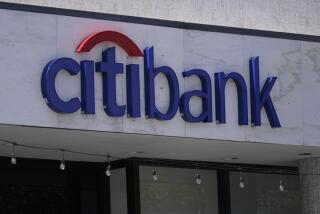Citizens Business Bank’s caution in boom times is a key to survival
- Share via
Few regions were hit harder by the Great Recession than the Inland Empire, where foreclosures turned neighborhoods into ghost towns and real estate projects dissolved into weeds and broken dreams.
So it’s not surprising that four of the five largest banks in the region failed, sunk by risky subprime mortgages and failed construction loans.
Citizens Business Bank was the exception. The bank, operated by holding company CVB Financial Corp., limited construction and land development loans to no more than 10% of its portfolio, far less than many of its peers.
Not only did the bank survive the worst financial downturn in a generation, it turned a profit throughout those years.
“We lost a lot of money on construction loans; we just didn’t have as much in construction loans as everyone else,” said Christopher D. Myers, CVB’s chief executive.
“We have to be smart about who we lend money to and how we lend money,” he said. “We kept our construction loan department small. A lot of it is knowing your customer and picking and choosing your clients well.”
With $6.7 billion in assets, Citizens is the largest financial institution based in the Inland Empire. Founded in 1974 in a single office in Chino, Citizens operates 45 branches from Laguna Beach to Stockton. Its headquarters are in Ontario.
As its name indicates, Citizens Business Bank specializes in serving the banking needs of businesses. This enables the bank to limit exposure to risky real estate development loans, which can be tempting during booms.
“In ‘05-06, some of the banks were growing 20% a year and we were growing maybe 10%,” Myers said. “When you look at the banks that got in trouble, a lot of them got outside their normal business practices and into higher-risk lending: construction lending and subprime mortgages. When times are booming, that can be very tempting. We tried to stick to what was the core of our business.”
It’s a model that has worked for decades. The company has turned a profit 146 consecutive quarters, or more than 36 years.
“We want to outperform the markets in down cycles and try to perform with the group in up cycles, or even slightly below,” Myers said.
The latest
Citizens just completed what is expected to be the most profitable year in the company’s history. CVB Financial reported net income of $70.3 million for the first nine months of last year, compared with $55.1 million a year earlier.
The bank builds long-term relationships with small and medium-size businesses.
“We’re a community bank and a business bank, and we focus on the local markets we’re in,” Myers said.
The company also is seeking to accelerate growth “through the acquisition of community banks in and adjacent to our existing geographic markets,” Myers said.
Financial results for entire year are scheduled to be released Wednesday.
Accomplishments
The bank’s record of profitability extends through multiple recessions, the Black Monday stock sell-off in 1987, the tech bubble bursting in 2000 and the collapse of the nation’s real estate and financial markets, which led to the Great Recession.
“The 146 consecutive quarters of profitability is one of the best records in the country,” Myers said. “I think it comes down to knowing who your customer is. We’re not trying to be all things to all people.
“Our objective is to form long-term relationships with the better small- to medium-sized, privately held and typically family-owned businesses that serve the areas we serve.”
Investors have benefited from the bank’s run of profitability. Those who invested $10,000 in the bank’s stock in 1974 and reinvested dividends would hold a stake worth more than $4 million today.
Challenges
As with most banks, Citizens’ fortunes still are subject to the vagaries of the economy. Worsening economic circumstances, for instance, could affect the ability of its borrowers to repay loans.
And even though weaker and smaller institutions have failed, especially during the recession, the bank still faces competition from other survivors, as well as from major national banks.
Myers said the bank is constantly facing competition on interest rates and loan terms. Some of that pricing he called “irrational.”
“When you’re chasing the better companies, price competition is part of the game,” he said. “We’re well positioned, because of our low cost of funds, to compete with any bank, big or small.”
Analyst views
Two analysts recommend buying CVB Financial’s stock, seven advise holding it and one suggests selling it now. They estimate, on average, that the stock will be trading at $15.93 in a year. That would be a drop from Friday’s close of $16.60.
Todd Hagerman, an analyst with Sterne, Agee & Leach Inc., described CVB as “a high-quality company,” praising it for growing loans and deposits.
He cautioned, however, that its stock is not attractively priced.
“We need a pullback in the shares to get more aggressive, given the current valuation,” he said.
More to Read
Inside the business of entertainment
The Wide Shot brings you news, analysis and insights on everything from streaming wars to production — and what it all means for the future.
You may occasionally receive promotional content from the Los Angeles Times.











